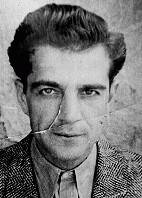
Leon Franko
Born: 1920
Bitola, Yugoslavia
Leon was born to a large, Ladino-speaking, Sephardic-Jewish family. The Frankos lived in a large house in ethnically diverse Bitola, a town located in the southern part of Yugoslav Macedonia, near the Greek border. Leon's father, Yiosef, was a successful fabric merchant. The Frankos' children attended Yugoslav public schools where they learned to speak Serbian.
1933-39: Upon completing his schooling, Leon became a fabric merchant in Bitola. A handsome man from a well-to-do family, Leon was popular. His friends often remarked that he looked like a movie star. His younger brother, Dario, idolized him.
1940-44: In April 1941 the Germans invaded Yugoslavia, and Macedonia was annexed to Bulgaria. The Bulgarians introduced anti-Jewish laws and cooperated with the Germans. Leon and Dario fled to Kastoria, a town in Italian-occupied Greece. There, Leon met and married Rebecca Pissirilo. After Italy surrendered, the Germans deported Kastoria's 700 Jews to Salonika, where they were assembled for deportation to Auschwitz. In Salonika, Leon's wife, who was nine months pregnant, was taken by the International Red Cross to a hospital.
Leon was one of 700 Jews deported by train from Salonika to Auschwitz on April 1, 1944. Both he and his wife perished. Their baby, Esther, was saved by a nurse in the hospital.